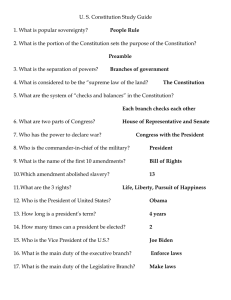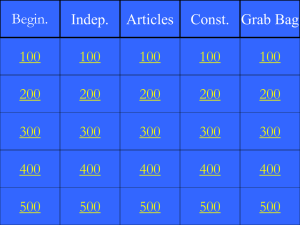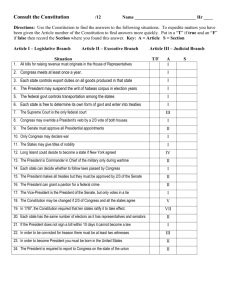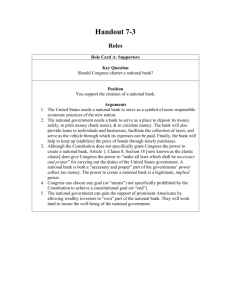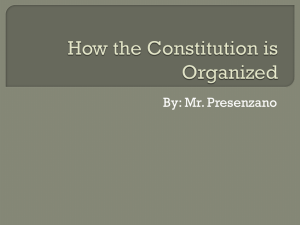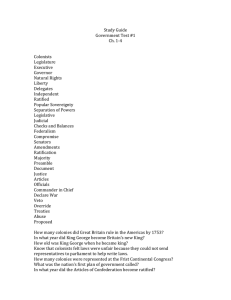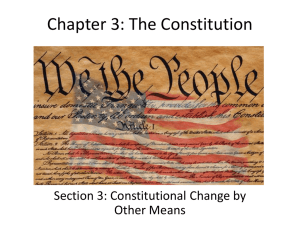Politics in Developing States from a Comparative Perspective: Part 2
advertisement
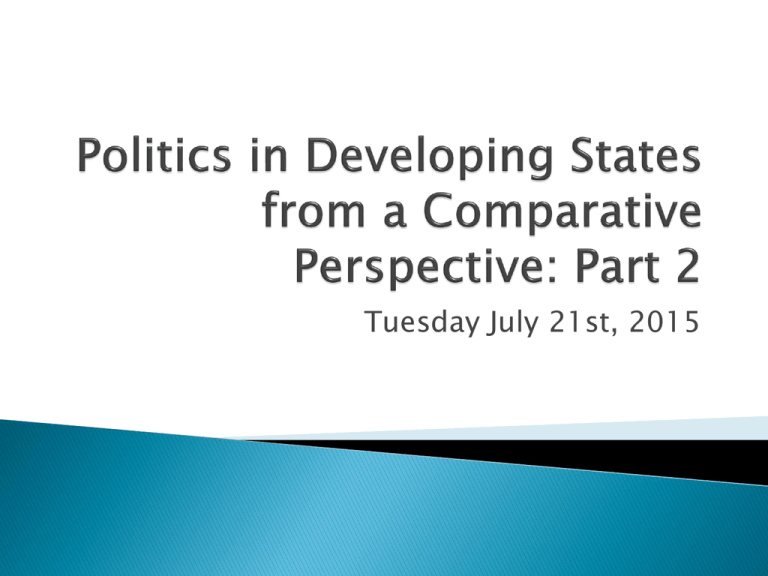
Tuesday July 21st, 2015 China ◦ Focus on economic development first Mexico ◦ Focus on political development first (currently, anyway) India ◦ Mixed focus on politics and economy Mali ◦ From stable to democracy to pseudo-civil war The world’s largest population (est. 1.35 bn) and third largest by area It will in a relatively short period of time overtake the US as the world’s largest economy An emerging world power, permanent membership on the UN Security Council Has demonstrated significant economic growth for an extended period of time, transitioning hundreds of million of citizens out of poverty. Single-party socialist state ◦ Chinese Communist Party ◦ Also a republic – no monarch Power primarily rests in the hand of the President Text notes three levels of government, with power at the federal, provincial and municipal levels. While nominally true, power rests such that the provincial and municipal powers could be removed without much trouble. The head of the Communist party (general secretary) is usually the President Theoretically, President’s legislative and executive power as Head of Government is shared with the National People’s Congress and the State Council It is the Politburo that practically acts as the cabinet and makes decisions with the President 8 parties other than the CCP exist, though they are basically puppet parties A Chinese Empire can, effectively be traced back to 2100 BCE, making it among the oldest and (easily) longest lasting in the world ◦ Strong central government, authoritarian rule Imperial era effectively ends by 1912 ◦ Armed uprising leads to civil war between the Chinese Communists and the Kuomintang Zedong’s People’s Liberation Army would become the dominant alternative to the Kuomintang. Japanese invasion of China during WW2 undercut the reputation of the Kuomintang While the civil war was put aside during WW2, it resumed shortly thereafter. ◦ Zedong’s PLA would win the war by 1949 ◦ The Kuomintang fled to Taiwan Zedong’s economic policies resulted in significant growth in the Chinese economy through 1976 ◦ Other tactics resulted in massive casualties due to starvation, political arrests and concentration camps Towards the end of Zedong’s rule, a relatively sharp division in the Communist movement emerged between pragmatists and revolutionaries Pragmatists would win out, though a split developed there too between quick capitalistic transition or slower transition Functionally, the idea of China as a communist state ended in the 1970s ◦ Though still strongly authoritarian Pluralism: Multiple places of power in a state National People’s Congress as a chamber of dissent? Within the party, maintaining a regional and governmental power base is necessary to ensure continued influence ◦ internalized accountability in the CCP Decentralization of economic planning in the 1970s is first step toward economic liberalization ◦ Production quotas still required, but surplus could be sold at market rates The 1990s saw the Introduction of Special Economic Zones: Areas where government intervention is significantly limited, greater foreign investment Population growth and growing wealth One of world’s fastest growing economies, but has slowed down somewhat recently CCP rule is predicated on improving standards of living – if those slow down, what is the long-term viability of single-party rule? Human Rights ◦ But maybe not why you think Wealth distribution and continued growth The rise of non-Chinese nationalism? Relationship with the US The environment? While, realistically, a democracy, marked by long periods of single-party rule Presidential system (traditionally a strong president) ◦ Power split with Congress, which is growing in power Considered a NIC ◦ Been on the cusp of being “developed” numerous times High levels of inequality Long European history Provided Spain significant wealth Gained independence in 1821 War with US and secession of Texas sent Mexican state into crisis ◦ The wealth has proven difficult for Mexico to retain for itself ◦ Early history defined by weak presidents ◦ Led to harsh dictatorship (though economic strength) Zapata revolution in early 1900s led to democratic institutions (but 70 years of 1 party rule) ◦ Itself a bit authoritarian in style Federal system, powers balanced (horizontally) between president and congress – in theory Vertical power split with states and District of Mexico City, though most power, until recently has resided at the centre ◦ Municipalities have some powers too, but funding dependent on higher levels of government (similar to Canada) States are not well unified, as there are massive differences in wealth across states Presidents are head of state and given significant powers in the constitution ◦ Presidential dominance ◦ Presidents directly responsible for most laws Until the 1980s, presidents were able to change the law easily, as one party dominate ◦ Constitution too, requires consent of 2/3rds of the congress Popular election and six year terms ◦ Since 2012: Enrique Pena Nieto Two main parties: Institutional Revolutionary Party (PRI) and National Action Party (PAN) ◦ PRI in power: 1930-2000; 2012◦ PAN in power 2000-2012 Congress and Senate, like the US, but generally very well unified until recently ◦ In 1990s, for the first time, the dominant party in the legislature and presidency were different ◦ Significant gridlock with the president’s party not holding a majority in the legislature Counting votes can be an adventure The Federal Electoral Institute, since 1988, has worked to become a well-respected, independent electoral commission. 2006 saw a series of mistakes, attempted fraud, missing ballot boxes and claims of misbehaviour by IFE Seems to have regained reputation in last election, but still accusations of vote-buying Mexico has both a strong resource economy and tourist economy ◦ Or it would if there was less corruption State-run economy for much of the 20th C ◦ Nationalization of major resource companies throughout the 60s and 70s (combined with significant lending) ◦ On the cusp of developed status before major downturn in the 1980s Significant liberalization with NAFTA ◦ Fell into another recession in the 1990s (IMF Bailout) ◦ Lost competitive advantage relative to China and India Massive violence due to war on drugs ◦ Kidnappings and corrupt government officials Movement of people across the US better NAFTA and manufacturing Long-term development depends on limiting political and economic corruption and much of the violence in the state. The world’s largest democracy, 2nd largest state on earth Significant diversity within the state Becoming a global economic force There has been political, ethnic and religious violence ◦ In part because of colonial past ◦ In part because of political failures Ancient civilization ◦ Dominant religious texts traced back to 1700 BCE Numerous wars for empire both local and international British Empire formalizes control over the subcontinent in the 1800s ◦ previously through British East India Company ◦ While high levels of investment (railroads and resource development), significant human rights abuses, repressive government Massive commitment to WW1 Indian National Congress, in its aftermath, arose under the leadership of Nehru and Gandhi ◦ Non-violent movement ◦ Though British soon recognized inevitability of independence, did not arrive until 1947 Partition of India and Pakistan, at independence led to a massive migration between states ◦ Significant amount of deaths due to violence and inadequate state response to refugees Dominion from 1947-1950 Secular, democratic, parliamentary republic ◦ In this time, creating the constitution Its constitution was important in the post-war period, explicitly limiting the government’s power and protecting individual rights Federal system: Indirectly elected president ◦ Presidential powers are strong in the constitution, but dependent on the Prime Minister and Cabinet (Council of Ministers) Two houses of parliament: ◦ Rajya Sabha (Council of States) – 6 year terms, state legislature-appointed ◦ Lok Sabha (Assembly of the People) – 543 members popularly elected (currently 2 appointed), can sit up to 5 years Major Parties: ◦ INC, BJP and the United Progressive Alliance ◦ Current PM Narendra Modi (2014- ) Immediately after independence, issues of poverty, infrastructure, little advanced industry and limited financial capabilities Sought development through socialist mechanisms ◦ High levels of government intervention in the economy ◦ High tariffs ◦ Nationalization of industries Major leaders in the non-aligned movement 1991 saw the government switch tact and move towards a liberal economic ideology ◦ Cutting red tape, tariffs and opening markets has led to long-term, significant economic development Currently 11th largest economy, will be third in the not-too distant future ◦ Strong textile, pharma and service industries Vastly inequitable development Population growth Religious tension Continued existence of the caste system Transition between the modern and traditional Regional tensions, economic and territorial ◦ Significant poverty contrasted with growing wealth ◦ As population continues to grow, government has trouble implementing effective social safety net, hugely expensive Currently facing a civil war: ◦ Islamic rebels hold much of the North of the state Previously among the most stable democracies in all of Africa, throughout the 1990s Development is not linear Colonialism implications still manifest Part of Ghanaian Empire until 13th century ◦ Would become dominant by the 14th century with the rise of the Mali Empire ◦ Later succumb to the Songhai Empire Controlled Saharan trade ◦ Economy based on gold, copper and the slave trade ◦ Drought, famine and conflict led to decline Late 19th Century, became a colony of France ◦ Human rights abuses, arbitrary borders ◦ Dislocation of local economy, for cash crops ◦ Slavery 1959, independence movement begins, achieve success by June 1960 Republic of Mali had a socialist bent and immediately allied with Soviet Union ◦ Despite centrally planned economy, poverty was not improved under socialists Military Coup in 1968, transitioned to a repressive one party state Economic pressure and popular democratic movements led to another military coup in 1991 and democratic government by 1992 Colonialism led to a broad collection of ethnicities and languages in the state Population has quadrupled since 1960, young state ◦ Poor healthcare and relatively high violence means short life expectancy ◦ Poor, ranked 175th of 187 on HDI ◦ Population, on average, lives on $1.25/day Constitution instituted in 1992, democratic, semi-presidential, republic President is a strong position National Assembly: 160 seats popularly elected (five year term) Eight major political parties ◦ Two term limit, five year terms ◦ Head of State and Commander-in-chief ◦ Prime Minister (the head of government) is appointed by the President ◦ Ethnic, regional, religious or gendered parties are illegal Presidential power has resulted in election issues ◦ The 1997 election resulted in a boycott by major political parties Violence in the North of the state has been consistent since the early 1990s Violence increased after President Toure was reelected in 2007 ◦ Military overthrew the president due to poor handling of the problem, though this just made things worse ◦ A new president was appointed by the constitutional court, though they were also deposed by the military With France’s help, Mali retook control of much of the North, but the process was damaging to the flow of food and aid to the area ◦ Still consistent rebel attacks in the rural areas Commodity boom means that economic development may be at hand Vulnerable to booms and busts ◦ High levels of inequality ◦ Political instability (lots of authoritarian tendencies) ◦ Low levels of human security

